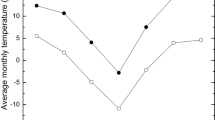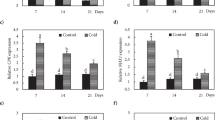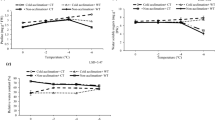Abstract
Cold stress is a major environmental factor that limits the distribution of plants and determines the spectrum and amount of secondary metabolites with a protective function. The most studied representative of the genus Hypericum, H. perforatum L. (St. John’s wort), is known as a producer of the photodynamic pigment hypericin, the unique bioactive compound structurally belonging to naphtodianthrones. In relation to the cosmopolitan distribution, we hypothesised that low temperature stress could increase the content of naphtodianthrones as a part of the adaptive mechanisms. Two strategies in preventing the freezing injury in the genus Hypericum were defined. Based on a frost-killing temperature (LT50) in untreated (control) plants and more than a 10 °C decrease in LT50 in cold-acclimated plants, we demonstrated the freezing tolerance for H. perforatum. On the contrary, the freezing avoidance was preferable in H. canariense—the species endemic to (sub)tropical Canary Islands and Madeira. The freezing tolerance/avoidance was related to the course of ABA accumulation/depletion in H. perforatum/H. canariense under a subfreezing temperature of −4 °C; however, the effect of dehydration or application of 76 μM ABA on the level of endogenous ABA was comparable. The 48-h exposure of H. perforatum control plants to −4 °C resulted in a 1.6-fold increase in the content of naphtodianthrones, along with the 1.5-fold increase of ABA. On the contrary, neither dehydration nor exogenous ABA stimulated the biosynthesis of these compounds. Our findings indicate possible integration of ABA signalling into naphtodianthrones biosynthesis under subfreezing conditions; this mechanism could be modified by plant tolerance to cold environments.







Similar content being viewed by others
References
Arumugam M, Lulu S, Kumari S, Kumari NVD (2013) Computational screening and evaluation of bioactive compounds against NS3 helicase of HCV. Int J Pharm Pharm Sci 5:370–376
Beck EH, Heim R, Hansen J (2004) Plant resistance to cold stress: mechanisms and environmental signals triggering frost hardening and dehardening. J Biosci 29:449–459
Bilavčík A, Zámečník J, Grospietsch M, Faltus M, Jadrná P (2012) Dormancy development during cold hardening of in vitro cultured Malus domestica Borkh. plants in relation to their frost resistance and cryotolerance. Trees 26:1181–1192
Bravo LA, Zuniga GE, Alberdi M, Corcuera LJ (1998) The role of ABA in freezing tolerance and cold acclimation in barley. Physiol Plant 103:17–23
Briskin DP, Gawienowski MC (2001) Differential effects of light and nitrogen on production of hypericins and leaf glands in Hypericum perforatum. Plant Physiol Biochem 39:1075–1081
Bruňáková K, Zámečník J, Urbanová M, Čellárová E (2011) Dehydration status of ABA-treated and cold-acclimated Hypericum perforatum L. shoot tips subjected to cryopreservation. Thermochim Acta 525:62–70
Chan Z (2012) Expression profiling of ABA pathway transcripts indicates crosstalk between abiotic and biotic stress responses in Arabidopsis. Genomics 100:110–115
Christmann A, Hoffmann T, Teplova I, Grill E, Muller A (2005) Generation of active pools of abscisic acid revealed by in vivo imaging of water-stressed Arabidopsis. Plant Physiol 137:209–221
Christmann A, Weiler EW, Steudle E, Grill E (2007) A hydraulic signal in root-to-shoot signalling of water shortage. Plant J 52:167–174
Churchill GC, Reaney MJT, Abrams SR, Gusta LV (1998) Effects of abscisic acid and abscisic acid analogs on the induction of freezing tolerance of winter rye (Secale cereale L.). Plant Growth Regul 25:35–45
Coste A, Vlase L, Halmagyi A, Deliu C, Coldea G (2011) Effects of plant growth regulators and elicitors on production of secondary metabolites in shoot cultures of Hypericum hirsutum and Hypericum maculatum. Plant Cell Tiss Org 106:279–288
Crockett SL, Robson NKB (2011) Taxonomy and chemotaxonomy of the genus Hypericum. Med Aromat Plant Sci Biotechnol 5:1–13
deMelo WDCMA, Lee AN, Perussi JR, Hamblin MR (2013) Electroporation enhances antimicrobial photodynamic therapy mediated by the hydrophobic photosensitizer, hypericin. Photodiagn Photodyn Ther 10:647–650
Dutta A, Sen J, Deswal R (2013) New evidences about strictosidine synthase (Str) regulation by salinity, cold stress and nitric oxide in Catharanthus roseus. J Plant Biochem Biotechnol 22:124–131
EP (2008) European Pharmacopoeia, 6th edn. Council of Europe, Strasbourg, France, 2, S2958
Fan J, Hill L, Crooks C, Doerner P, Lamb C (2009) Abscisic acid has a key role in modulating diverse plant-pathogen interactions. Plant Physiol 150:1750–1761
Gadzovska S, Maury S, Delaunay A, Spasenoski M, Joseph C, Hagege D (2007) Jasmonic acid elicitation of Hypericum perforatum L. cell suspensions and effects on the production of phenylpropanoids and naphtodianthrones. Plant Cell Tissue Org Cult 89:1–13
Gadzovska S, Maury S, Delaunay A, Spasenoski M, Hagege D, Courtois D, Joseph C (2013) The influence of salicylic acid elicitation of shoots, callus, and cell suspension cultures on production of naphtodianthrones and phenylpropanoids in Hypericum perforatum L. Plant Cell Tissue Org Cult 113:25–39
Gamborg OL, Miller RA, Ojima K (1968) Nutrient requirements of suspension cultures of soybean root cells. Exp Cell Res 50:151–158
Germ M, Stibilj V, Kreft S, Gaberščik A, Kreft I (2010) Flavonoid, tannin and hypericin concentrations in the leaves of St. John’s wort (Hypericum perforatum L.) are affected by UV-B radiation levels. Food Chem 122:471–474
Ghassemian M, Lutes J, Chang HS, Lange I, Chen W, Zhu T, Wang X, Lange BM (2008) Abscisic-acid-induced modulation of metabolic and redox control pathways in Arabidopsis thaliana. Phytochemistry 69:2899–2911
Gusta LV, Trischuk R, Weiser CJ (2005) Plant cold acclimation: the role of abscisic acid. J Plant Growth Regul 24:308–318
Guy CH (1999) Molecular responses of plants to cold shock and cold acclimation. J Mol Microb Biotechnol 1:231–242
Heidarvand L, Amiri RM (2010) What happens in plant molecular responses to cold stress? Acta Physiol Plant 32:419–431
Janáček J, Prášil I (1991) Quantification of plant frost injury by nonlinear fitting of an S-shaped function. Cryoletters 12:47–52
Janska A, Marsik P, Zelenkova S, Ovesna J (2010) Cold stress and acclimation—what is important for metabolic adjustment? Plant Biol 12:395–405
Kaplan F, Kopka J, Haskell DW, Zhao W, Schiller KC, Gatzke N, Sung DY, Guy ChL (2004) Exploring the temperature-stress metabolome of Arabidopsis. Plant Physiol 136:4159–4168
Kaplan F, Kopka J, Sung DY, Zhao W, Popp M, Porat R, Guy CL (2007) Transcript and metabolite profiling during cold acclimation of Arabidopsis reveals an intricate relationship of cold-regulated gene expression with modifications in metabolite content. Plant J 50:967–981
Kosová K, Prášil IT, Vítámvás P, Dobrev P, Motyka V, Floková K, Novák O, Turečková V, Rolčík J, Pešek B, Trávníčková A, Gaudinová A, Galiba G, Janda T, Vlasáková E, Prášilová P, Vanková R (2012) Complex phytohormone responses during the cold acclimation of two wheat cultivars differing in cold tolerance, winter Samantha and spring Sandra. J Plant Physiol 169:567–576
Lang V, Mäntylä E, Welin B, Sundberg B, Palva ET (1994) Alterations in water status, endogenous abscisic acid content, and expression of rab18 gene during the development of freezing tolerance in Arabidopsis thaliana. Plant Physiol 104:1341–1349
Lichtenthaler HK, Buschmann C (2001) Chlorophylls and carotenoids: measurement and characterization by UV-VIS spectroscopy. In: Wrolstad RE, Acree TE, An H, Decker EA, Penner MH, Reid DS, Schwartz SJ, Shoemaker CF, Sporns P (eds) Current protocols in food analytical chemistry (CPFA). Wiley, New York, pp F4.3.1–F4.3.8
Liu CL, Chen HP, Liu EE, Peng XX, Lu SY, Guo ZF (2003) Multiple tolerance of rice to abiotic stresses and its relationship with ABA accumulation. Acta Agron Sin 29:725–729
Luo J, Liu L, Wu CD (2001) Enhancement of paclitaxel production by abscisic acid in cell suspension cultures of Taxus chinensis. Biotechnol Lett 23:1345–1348
Mäntylä E, Lang V, Palva ET (1995) Role of abscisic acid in drought-induced freezing tolerance, cold acclimation, and accumulation of LTI78 and RAB18 Proteins in Arabidopsis thaliana. Plant Physiol 107:141–148
Marczak L, Kachlicki P, Koźniewski P, Skirycz A, Krajewski P, Stobiecki M (2008) Matrix-assisted laser desorption/ionization time-of-flight mass spectrometry monitoring of anthocyanins in extracts from Arabidopsis thaliana leaves. Rapid Commun Mass Spectrom 22:3949–3956
Miura K, Furumoto T (2013) Cold signaling and cold response in plants. Int J Mol Sci 6:5312–5337
Murashige T, Skoog F (1962) A revised medium for rapid growth and bio assays with tobacco tissue cultures. Physiol Plant 15:473–497
Nahrstedt A, Butterweck V (1997) Biologically active and other chemical constituents of the herb of Hypericum perforatum L. Pharmacopsychiatry 30:129–134
Paparella C, Savatin DV, Marti L, Lorenzo J, Ferrari S (2014) The Arabidopsis LYSIN MOTIF-CONTAINING RECEPTOR-LIKE KINASE3 regulates the cross talk between immunity and abscisic acid responses. Plant Physiol 165:262–276
Penjweini R, Loew HG, Breit P, Kratky KW (2013) Optimizing the antitumor selectivity of PVP-Hypericin re A549 cancer cells and HLF normal cells through pulsed blue light. Photodiagn Photodyn 10:591–599
Petijova L, Bruňáková K, Zámečník J, Zubrická D, Mišianiková A, Kimáková K, Čellárová E (2014) Relation between frost tolerance and post-cryogenic recovery in Hypericum spp. Cryoletters 35:171–179
Pillai PP, Nair AR (2014) Hypericin biosynthesis in Hypericum hookerianum Wight and Arn: investigation on biochemical pathways using metabolite inhibitors and suppression subtractive hybridization. C R Biol 337:571–580
Prášil I, Zámečník J (1998) The use of a conductivity measurement method for assessing freezing injury I. Influence of leakage time, segment number, size and shape in a sample on evaluation of the degree of injury. Environ Exp Bot 40:1–10
Priest DM, Ambrose SJ, Vaistij FE, Elias L, Higgins GS, Ross ARS, Abrams SR, Bowles DJ (2006) Use of the glucosyltransferase UGT71B6 to disturb abscisic acid homeostasis in Arabidopsis thaliana. Plant J 46:492–502
Rada F, Briceno B, Azócar A (2008) How do two Lupinus species respond to temperatures along an altitudinal gradient in the Venezuelan Andes? Rev Chil Hist Nat 81:335–343
Ramakrishna A, Ravishankar GA (2011) Infuence of abiotic stress signals on secondary metabolites in plants. Plant Signal Behav 6:1720–1731
Rivas F, Fornes F, Rodrigo MJ, Zacarias L, Agusti M (2011) Changes in carotenoids and ABA content in Citrus leaves in response to gridling. Sci Hortic 127:482–487
Sakai A, Larcher W (1987) Frost survival of plants. Responses and adaptations to freezing stress. In: Billings WD, Golley F, Lange OL, Olson JS, Remmert H (eds) Ecological studies, 1st edn. Springer, Berlin, pp 1–317
Seo M, Koshiba T (2002) Complex regulation of ABA biosynthesis in plants. Trends Plant Sci 7:41–48
Southwell IA, Bourke CA (2001) Seasonal variation in hypericin content of Hypericum perforatum L. (St. John’s Wort). Phytochemistry 56:437–441
Squeo FA, Rada F, Azócar A, Goldstein G (1991) Freezing tolerance and avoidance in high tropical Andean plants: is it equally represented in species with different plant height? Oecologia 86:378–382
Squeo FA, Rada F, García C, Ponce M, Rojas A, Azócar A (1996) Cold resistance mechanisms in high desert Andean plants. Oecologia 105:552–555
Sun DY, Yin ZJ, Wu ShJ, Su J, Shi Sh, Wu H, Xiao FH, Qi JL, Liu Zh, Pang YJ, Shen HG, Yang YH (2007) Effects of abscisic acid on the secondary metabolism of cultured Onosma paniculatum cells. Russ J Plant Physiol 54:530–535
Thomashow MF (1999) Plant cold acclimation: freezing tolerance genes and regulatory mechanisms. Annu Rev Plant Physiol Plant Mol Biol 50:571–599
Tolonen A, Hohtola A, Jalonen J (2003) Fast high-performance liquid chromatographic analysis of naphthodianthrones and phloroglucinols from Hypericum perforatum extracts. Phytochem Anal 14:306–309
Turečková V, Novák O, Strnad M (2009) Profiling ABA metabolites in Nicotiana tabacum L. leaves by ultra-performance liquid chromatography-electrospray tandem mass spectrometry. Talanta 80:390–399
Wang XJ, Loh ChS, Yeoh HH, Sun WQ (2002) Drying rate and dehydrin synthesis associated with abscisic acid-induced dehydration tolerance in Spathoglottis plicata orchidaceae protocorms. J Exp Bot 53:551–558
Wölfle U, Seelinger G, Schempp CM (2014) Topical application of St. John’s Wort (Hypericum perforatum). Planta Med 80:109–120
Zhao JT, Davis LC, Verpoorte R (2005) Elicitor signal transduction leading to production of plant secondary metabolites. Biotechnol Adv 23:283–333
Zobayed SMA, Afreen F, Kozai T (2005) Temperature stress can alter the photosynthetic efficiency and secondary metabolite concentrations in St. John’s wort. Plant Physiol Biochem 43:977–984
Zobayed SMA, Afreen F, Goto E, Kozai T (2006) Plant-environment interactions: accumulation of hypericin in dark glands of Hypericum perforatum. Ann Bot 98:793–804
Acknowledgments
This work was supported by the Slovak Research and Development Agency under contracts No. APVV 0040-10, SK-BG 0012-10, the Scientific Grant Agency of the Slovak Ministry of Education No. 1/142/11, the Czech Science Foundation (Nr. 14-34792S) and by the Ministry of Education, Youth and Sports of the Czech Republic (The National Program for Sustainability I, Nr. LO1204).
Conflict of interest
The authors declare that they have no conflict of interest.
Author information
Authors and Affiliations
Corresponding author
Electronic supplementary material
Below is the link to the electronic supplementary material.
Rights and permissions
About this article
Cite this article
Bruňáková, K., Petijová, L., Zámečník, J. et al. The role of ABA in the freezing injury avoidance in two Hypericum species differing in frost tolerance and potential to synthesize hypericins. Plant Cell Tiss Organ Cult 122, 45–56 (2015). https://doi.org/10.1007/s11240-015-0748-9
Received:
Accepted:
Published:
Issue Date:
DOI: https://doi.org/10.1007/s11240-015-0748-9




